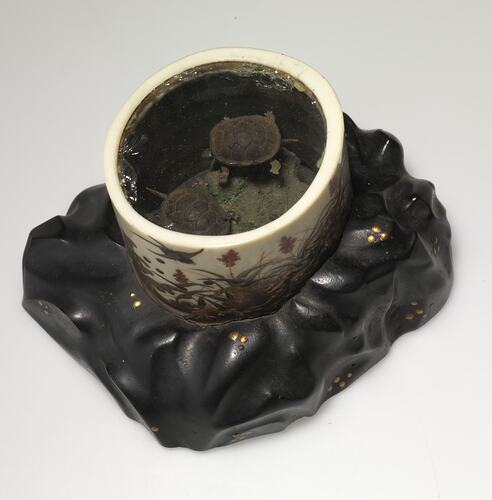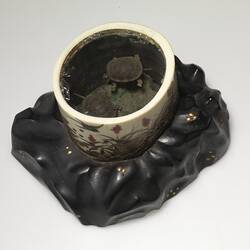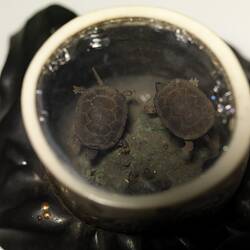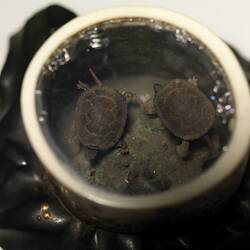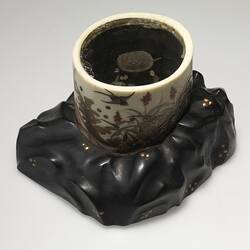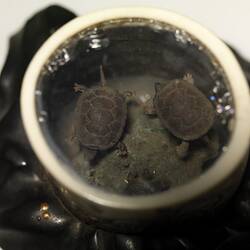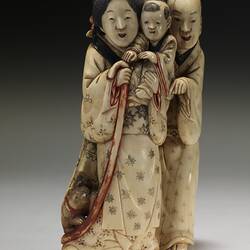Summary
Shibayama-style decoration on an ivory paperweight manufactured in Japan in the early Meiji period (1868-1880).
Comprised of an ivory cylinder decorated with swallows in flight over an undulating, wave-like landscape mounted on a wooden 'rock', on the inside of the paperweight are several small carved articulated tortoises. The opening of the cylinder of covered with clear glass.
Although the technique is very similar to Shibayama inlay - in which elaborately finished pieces of ivory, mother-of-pearl, tortoiseshell, horn and other materials being inlaid into gold lacquered ground, wooden panels, or ivory grounds - the decorative technique applied here is different, and would not correctly be classified as such.
However, as a decorative style, Shibayama gained exposure in the West after being exhibited at the 1893 Chicago International Exhibition, which in turn encouraged a strong export market that flourished during the Taisho (1912-1925) and Showa (1926- ) periods.
For the uninitiated, objects such as this paperweight that were produced in a similar style appealed to this market. Several Australian firms advertised the sale of Shibayama during the 1890s, along with other Japanese decorative art forms that had become popular, in part due to the exposure at the International Exhibitions.
Physical Description
Hollow ivory cylinder, carved all around with birds in flight, waves, and leaf forms, sitting on a wooden 'rock'. The inside of the cylinder looks like a pond with two turtles with moving limbs, and a turtle without moving limbs on rocks. Clear glass cover to top of pond, with many chips around edge.
More Information
-
Collection Names
-
Collecting Areas
-
Acquisition Information
Cultural Gifts Donation from Dr Will Twycross, 23 Jan 2009
-
Acknowledgement
Donated through the Australian Government's Cultural Gifts Program
-
Place & Date Made
Japan, 1868-1880
early Meiji Period; Edo Period, 1603-1867; Meiji Period, 1868-1912 -
Place & Date Exhibited
Royal Exhibition Building (REB), Nicholson Street, Carlton, Greater Melbourne, Victoria, Australia, 1880-1881
-
Collector
Mr John Twycross, Elsternwick, Greater Melbourne, Victoria, Australia, 1880
-
Inscriptions
Marked on underside of base in red.
-
Classification
Royal exhibition building, International exhibitions, Exhibition heritage
-
Category
-
Discipline
-
Type of item
-
Overall Dimensions
100 mm (Width), 100 mm (Depth), 80 mm (Height)
-
Maximum dimensions
115 mm (Length), 98 mm (Width), 84 mm (Height)
Measurement From Conservation.
-
Maximum dimensions
115 mm (Length), 98 mm (Width), 84 mm (Height)
Measurement From Conservation.
-
Keywords
Exhibitions: Melbourne International, 1880-1881, Ivory, Japanese Art, Lacquerware, Paperweights, Royal Exhibition Building
